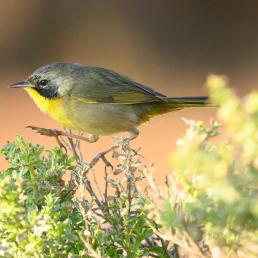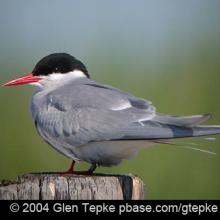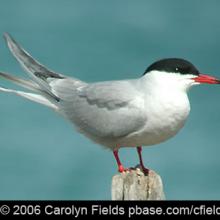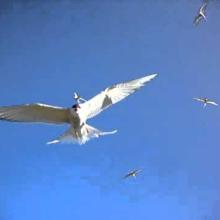

Join BirdNote tomorrow, November 30th!
Illustrator David Sibley and actor H. Jon Benjamin will face off in the bird illustration battle of the century during BirdNote's Year-end Celebration and Auction!
The bill and legs of Arctic Terns are shorter than those of Common Terns. Because Arctic Terns breed in the Arctic and winter in the Antarctic, they are subject to much colder weather than are Common Terns. Birds' bills and legs lose heat, because they're not covered by feathers. Birds in cold climates have short bills and legs, lessening their exposure.
Tell a friend about the BirdNote podcast!
BirdNote ®
Why Arctic Terns Have Short Beaks
Written by Dennis Paulson
This is BirdNote!
[Common Tern calls]
Environmental conditions shape birds’ bodies, even birds belonging to the same family. For example, consider the terns. [Common Tern calls] The Common Terns you’re hearing have long, pointed bills they use to catch small fish. They migrate along both coasts and through the interior in spring and fall, on their way between nesting grounds in Canada and their winter home in the tropics. By migrating, they move from one warm and productive environment to another. [Common Tern calls]
Their close relative, Arctic Terns, look much alike, but both their bills and legs are shorter. [Arctic Tern calls] Both species feed in exactly the same way, so why would the Arctic Tern’s bill and legs be shorter?
Well, because Arctic Terns breed in the Arctic and winter in Antarctica [Arctic Tern calls], they’re subject to much more severe weather than are Common Terns. Because birds’ bills and legs are not covered by feathers, they lose heat. It just makes sense then for birds in cold climates to have short bills and legs – and less exposure to the cold.
You can compare photos of the Arctic Tern and the Common Tern — and learn more about both — on our website, BirdNote.org. And if you know someone who can’t catch BirdNote at the time it’s aired, let them know they can get BirdNote online or as a podcast, any time day or night. I’m Michael Stein.
###
Bird audio provided by The Macaulay Library of Natural Sounds at the Cornell Lab of Ornithology, Ithaca, New York. Common Tern recorded by C.A. Sutherland and R.S. Little. Arctic Tern recorded by G.A. Keller.
Ambient waves recorded by J. Kessler, Kessler Productions
Producer: John Kessler
Executive Producer: Chris Peterson
© 2016 Tune In to Nature.org January 2013/2018/2021 Narrator: Michael Stein
ID# 012507ARTE2KPLU ARTECOTE-01b









